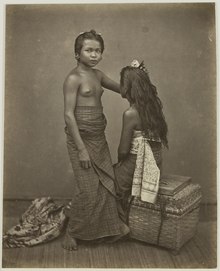Slavery in Indonesia
| Part of a series on |
| Forced labour and Slavery |
|---|
 |




Chattel slavery excisted in the territory that would become the modern state of Indonesia until the 20th-century. Due to the fact that the Maritime South Asian archipelago corresponding to Indonesia was not unified until 1949, the history of slavery in Indonesia is not uniform, but did have common features and a somewhat common history.
Slavery and slave trade is known to have excisted during the Ancient Hindu-Buddhistic states in Indonesia, though the information is somewhat limited. When the islands converted to Islam and transformed into Islamic sultanates during the 15th-century, the institution of slavery came to be managed in accordance with Islamic law and therefore took on similar characteristics as the slavery in the rest of the Muslim world, and non-Muslim peoples were captured by Muslim pirates from the Sulu and Celebes who sold them to slavery in the Islamic sultanates.
From the 17th-century onward, the Company rule in the Dutch East Indies (1610–1800) and then the Colonial Dutch East Indies (1800–1949) expanded over the archipelago. The Dutch colonists used slave labor in their agriculture. The Dutch banned slave trade in 1811 and slavery in 1860. The Dutch prohibition of slavery expanded in parallell with the Dutch control ove the archipelago, and by 1910, slavery in the East Indies was seen as effectively abolished, though cases of chattel slavery was still discovered as late as the 1940s.
Hindu-Buddhist antiquity[edit]
The rulers in the Hindu-Buddhist states in Indonesia are known to have used slave labor to cultivate their land, which was common in the Indonesian states, where there was no lack of land but rather of people and laborers to cultivate it, and slaves are noted to have excisted in both royal palaces and temples in Ancient Indonesia.[1]
Slave owning was reportedly not restricted to royalty; it was reported that commoners often owned slaves, and that rich merchants could own hundreds of slaves.[2]
In 15th-century Melaka, both enslaved laborers, concubines and debt bondage was noted to excist.[3]
Islamic sultanates[edit]
The introduction of Islam influenced the institution of slavery, which was adjusted to fit Islamic law. Islamic law prohibited the enslavement of Muslims, and non-Muslim peoples therefore became the preferred targets for enslavement, and victimized by Muslim pirates from the Sulu Islands, who became the slave suppliers of the Islamic sultanates in South Asia.[4] [5]
Dutch East Indies[edit]
During the Company rule in the Dutch East Indies (1610–1800), the Dutch established a significant plantation economy on Java. Due to the difficulty to engage free laborers, the Dutch colonists started to use slaves as agriculture laborers, and a significant slave market was established in Batavia.[6]
The Dutch banned slave trade in the Dutch colonial empire in 1818, and slavery in 1863.[7] However, slavery in the Dutch East Indies predated the Dutch prohibition in the rest of the Empire. Slave trade was banned in the East Indies in 1811.[8] During the first half of the 19th-century, when the Western powers banned slavery in their colonies, The Netherlands were internationally criticized for the slavery in the East Indies. On 1 January 1860, the Dutch banned slavery in the Dutch East Indies. [9]
The Dutch slavery abolition could only be enforced in the parts of Indonesia which were under Dutch control and thus subject to Dutch law, which meant that slavery was only abolished in about a quarter of Indonesia, such as Java.[10] Emancipation thus expanded in parallell with Dutch colonial expansion, and in 1910, when the Dutch had effective control over the entire archipelago, emancipation was considered to have been effectively enforced.[11][12]
In practice however the Dutch colonial authorities never truly had full control over the East Indies, and chattel slavery is known to have excisted in some parts of the archipelago as late as the 1940s.[13]
See also[edit]
- Slavery in Malaysia
- Human rights in Indonesia
- Human trafficking in Indonesia
- Sex trafficking in Indonesia
- History of slavery in the Muslim world
- History of concubinage in the Muslim world
References[edit]
- ^ Klein, M. A. (2014). Historical Dictionary of Slavery and Abolition. Storbritannien: Rowman & Littlefield Publishers. p. 216
- ^ Klein, M. A. (2014). Historical Dictionary of Slavery and Abolition. Storbritannien: Rowman & Littlefield Publishers. p. 216
- ^ Klein, M. A. (2014). Historical Dictionary of Slavery and Abolition. Storbritannien: Rowman & Littlefield Publishers. p. 216
- ^ Klein, M. A. (2014). Historical Dictionary of Slavery and Abolition. Storbritannien: Rowman & Littlefield Publishers. p. 216-217
- ^ Warren, J. F. (2007). The Sulu Zone, 1768-1898: The Dynamics of External Trade, Slavery, and Ethnicity in the Transformation of a Southeast Asian Maritime State. Singapore: Singapore University Press.
- ^ Klein, M. A. (2014). Historical Dictionary of Slavery and Abolition. Storbritannien: Rowman & Littlefield Publishers. p. 217
- ^ Klein, M. A. (2014). Historical Dictionary of Slavery and Abolition. Storbritannien: Rowman & Littlefield Publishers. p. 217
- ^ Campbell, G. (2004). Structure of Slavery in Indian Ocean Africa and Asia. Storbritannien: Taylor & Francis.
- ^ Campbell, G. (2004). Structure of Slavery in Indian Ocean Africa and Asia. Storbritannien: Taylor & Francis.
- ^ Campbell, G. (2004). Structure of Slavery in Indian Ocean Africa and Asia. Storbritannien: Taylor & Francis.
- ^ Klein, M. A. (2014). Historical Dictionary of Slavery and Abolition. Storbritannien: Rowman & Littlefield Publishers. p. 217
- ^ Campbell, G. (2004). Structure of Slavery in Indian Ocean Africa and Asia. Storbritannien: Taylor & Francis.
- ^ Campbell, G. (2004). Structure of Slavery in Indian Ocean Africa and Asia. Storbritannien: Taylor & Francis.
